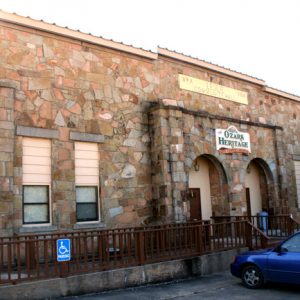calsfoundation@cals.org
Ozark Heritage Arts Center and Museum
Housed in a historic Depression-era building constructed of native stone, the Ozark Heritage Arts Center and Museum in Leslie (Searcy County) collects and exhibits the rich musical, cultural, and historical heritage of the Ozark Mountain region.
During the Depression, the citizens of Leslie approached the Works Progress Administration (WPA) to construct a gymnasium to complement the school built in 1910 during the city’s boom years. The native-stone building was completed and opened in 1938; it was used by the school system for the next forty-eight years, until 1986, when the system constructed new facilities nearby.
School superintendent Ed Bradberry is generally given credit for the idea to convert the empty gymnasium into an arts center, and retired local merchants Rex and Daphne Killebrew are credited with spearheading the fundraising efforts to make that happen. The Killebrews donated $200,000 (about eighty percent of the total needed) for the renovation efforts, which took nearly four years. After the Ozark Heritage Arts Center and Museum opened in August 1990, the Killebrews donated another $300,000 in stocks as an endowment for the non-profit organization. The center houses an acoustically impressive 300-seat theater that takes up most of the old gymnasium area, as well as an art gallery on the first floor and a museum on a second floor.
Each June since 1997, the signature event for the Killebrew Theater has been an annual fiddle contest. One of just three in the state, the contest offers three divisions for fiddlers, all of whom must be Arkansas residents. In addition, bluegrass performances are presented the fourth Saturday of each month throughout the year, and monthly open-microphone nights are held. The theater is equipped with screening facilities as well, which are used twice a month to present a series of oral histories videotaped during the early 1990s by a local volunteer and funded by a Rockefeller Foundation grant.
From April through December, the art gallery changes exhibits on a monthly basis, opening each new exhibit with a reception. Each year, competitions are held for local students and adult artists. The gallery has become a regular stopping point for statewide art tours.
The heritage museum houses four rooms of items and artifacts from the area, from an 1820s loom to typing-class typewriters, cheerleader outfits, and a dentist office from the mid-twentieth century. Each of the rooms has a general theme, from life in the 1800s to the boom years of Leslie, as well as life in the outlying communities and the tools and implements for farm life. Railroads and the timber industry were vital to the development of the area, and each is explored through materials from the period. Also included are photos of whittlers and a selection of their knives, given that Colliers magazine proclaimed Leslie the whittling capital of America in 1955, a statement echoed by the New York Times in 1988.
The collection also includes items such as a fiddle used by local resident Abbie Morrison (who, with his twin brother, Apsie, performed in fiddling contests in Arkansas and Missouri, and had a recording session with their string band in Memphis in 1930); an apple press from the former 30,000-tree fruit orchard east of the city; a number of carvings such as a stagecoach and team and dress canes from the whittlers; a time-stamp machine from the local Missouri and North Arkansas (M&NA) railroad office; postal scales and ledgers reflecting births, deaths, and taxes during the town’s boom years; and photos of past residents as they lived and created the heritage of the area.
For additional information:
Ozark Heritage Arts Center and Museum. https://www.arkansas.com/leslie/landmarks/ozark-heritage-arts-center-museum (accessed August 26, 2023).
Satterfield, Archie. Country Towns of Arkansas. Castine, ME: Country Roads Press, 1995.
Larry Green
Ozark Heritage Arts Center and Museum





Comments
No comments on this entry yet.